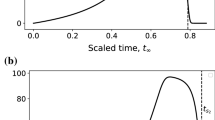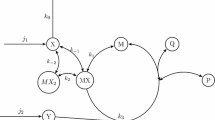Abstract
The nonlinear response of the simplest irreversible Michaelis – Menten enzyme is considered. In the context of metabolic networks, i.e. in vivo, the enzyme is subject to sustained, frequently time-dependent, input fluxes that keep the system out of equilibrium. The connection between the fluxes and the response is investigated by means of a new sensitivity analysis. The kinetics of the enzyme is simple enough to allow for the computations to be carried out analytically. In particular, a set of sensitivities of the response with respect to the substrate influx, the susceptibilities, is derived. The susceptibilities are multivariate functions and thus are suitable for predicting complete progress curves of several variables of biochemical interest, namely, rates and concentrations. This is shown by means of an example. The relationship between the susceptibilities and the stoichiometry of the reaction is also taken into account. Moreover, all the required information comes from decay experiments of initial concentrations, which are common in enzymological setups.
Similar content being viewed by others
References
Carlitz, L., 1965. The coefficients in an asymptotic expansion. P. Am. Math. Soc. 16, 248–252.
Carpenter, R.H.S., 2004. Homeostasis: a plea for a unified approach. Adv. Physiol. Educ. 28, S180–S187.
Corless, R.M., Gonnet, G.H., Hare, D.E.G., Jeffrey, D.J., Knuth, D.E., 1996. On the Lambert Ω function. Adv. Comput. Math. 5, 329–359.
Duggleby, R.G., 1983. Determination of the kinetic properties of enzymes catalysing coupled reaction sequences. Biochim. Biophys. Acta 744, 249–259.
Duggleby, R.G., 1995. Analysis of enzyme progress curves by non-linear regression. Methods Enzymol. 249, 61–90.
Duggleby, R.G., Clarke, R.B., 1991. Experimental designs for estimating the parameters of the Michaelis–Menten equation from progress curves of enzyme-catalysed reactions. Biochim. Biophys. Acta 1080, 231–236.
Duggleby, R.G., Morrison, J.F., 1977. The analysis of progress curves for enzyme-catalysed reactions by non-linear regression. Biochim. Biophys. Acta 481, 297–312.
Duggleby, R.G., Nash, J.C., 1989. A single parameter family of adjustments for fitting enzyme kinetic models to progress curve data. Biochem. J. 257, 57–64.
Gessel, I., Stanley, R.P., 1978. Stirling polynomials. J. Comb. Theory A 24, 24–33.
Goudar, C.T., Sonnad, J.R., Duggleby, R.G., 1999. Parameter estimation using a direct solution of the integrated Michaelis–Menten equation. Biochim. Biophys. Acta 1429, 377–383.
Graham, L., Knuth, D.E., Patashnik, O., 1994. Concrete Mathematics. A Foundation for Computer Science. Addison-Wesley, Reading, MA.
Heinrich, R., Rapoport, T.A., 1974. A linear steady-state treatment of enzymatic chains. General properties, control and effector strength. Eur. J. Biochem. 42, 89–95.
Kacser, H., Burns, J.A., 1973. The control of flux. Symp. Soc. Exp. Biol. 32, 65–104.
Kremling, A., Jahreis, K., Lengeler, J., Gilles, E., 2000. The organization of metabolic reaction networks: a signal-oriented approach to cellular models. Metab. Eng. 2, 190–200.
Rodríguez, Y., Torralba, A.S., Montero, F., 2002. Periodic signal transmission through metabolic pathways with Michaelian kinetics. J. Phys. Chem. B 106, 5536–5542.
Schnell, S., Maini, P., 2000. Enzyme kinetics at high enzyme concentration. Bull. Math. Biol. 62, 483–499.
Schnell, S., Mendoza, C., 1997. Closed form solution for time-dependent enzyme kinetics. J. Theor. Biol. 187, 207–212.
Schnell, S., Mendoza, C., 2000. Time-dependent closed form solutions for fully competitive enzyme reactions. Bull. Math. Biol. 62, 321–336.
Schnell, S., Mendoza, C., 2001. A fast method to estimate kinetic constants for enzyme inhibitors. Acta Biotheor. 49, 109–113.
Torralba, A.S., 2003. Susceptibility of non-linear systems as an approach to metabolic responses. Bioinformatics 19, 2428–2435.
Torralba, A.S., Yu, K., Shen, P., Oefner, P.J., Ross, J., 2003. Experimental test of a method for determining causal connectivities of species in reactions. Proc. Natl. Acad. Sci. U.S.A. 100, 1494–1498.
Author information
Authors and Affiliations
Corresponding author
Rights and permissions
About this article
Cite this article
Torralba, A.S., Rodríguez, Y. Susceptibilities of an Irreversible Michaelis – Menten Enzyme. Bull. Math. Biol. 68, 1335–1353 (2006). https://doi.org/10.1007/s11538-006-9111-y
Received:
Accepted:
Published:
Issue Date:
DOI: https://doi.org/10.1007/s11538-006-9111-y




